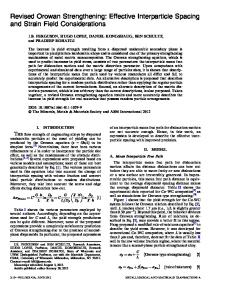Phase-Field Simulation of Orowan Strengthening by Coherent Precipitate Plates in an Aluminum Alloy
- PDF / 2,693,229 Bytes
- 15 Pages / 593.972 x 792 pts Page_size
- 115 Downloads / 379 Views
N
PLATE-SHAPED precipitates are often key strengthening constituents in age-hardenable aluminum alloys.[1–16] Typical examples include {100}a plates of h¢ phase in Al-Cu alloys,[7–9] {111}a plates of T1 phase in Al-Cu-Li alloys,[10–12] and {111}a plates of X phase in Al-Cu-Mg and Al-Cu-Mg-Ag alloys.[13,14] These precipitate plates are fully coherent with the surrounding aluminum matrix phase within their habit planes. While the formation mechanisms and growth behavior of these plate-shaped precipitates have received considerable attention, there is currently little detailed quantitative understanding of the interactions between these precipitate plates and gliding dislocations and the strengthening effects produced by such precipitate plates. There has been a lack of information on the intrinsic resistance of these precipitate plates to dislocation shearing and the quantitative relationship between the spatial distribution
HONG LIU, Research Fellow, is with the Department of Materials Engineering, Monash University, Clayton, VIC 3800, Australia, and also with the Department of Materials Science and Engineering, The Ohio State University, 2041 College Road, Columbus, OH 43210. YIPENG GAO, Postdoctoral Research Fellow, and YUNZHI WANG, Professor, are with the Department of Materials Science and Engineering, The Ohio State University. Contact e-mail: [email protected] LIANG QI, Assistant Professor, is with the Department of Materials Science and Engineering, University of Michigan, 2300 Hayward Street, Ann Arbor, MI 48109. JIAN-FENG NIE, Professor, is with the Department of Materials Engineering, Monash University. Contact e-mail: [email protected] Manuscript submitted August 21, 2014. METALLURGICAL AND MATERIALS TRANSACTIONS A
and size distribution of precipitate plates and alloy yield strength. The current versions of the Orowan equation that are used to predict the critical resolved shear stress increment (DCRSS) of these alloys are modified from the equations for spherical particles, and the validity of these modifications has not been thoroughly examined by experiments or simulations.[15–31] Furthermore, the influence of elastic interactions between the coherent precipitate plates and dislocations, and between dislocation segments, needs to be considered and, if necessary, incorporated into the strengthening equations.[25,26] Therefore, the main objective of this study is to provide detailed and accurate information on dislocation-precipitate interactions in one of these alloys. The results to be gained and models to be developed are expected to provide guidelines to the optimization of precipitate distribution for higher strength. To avoid tracking the exact position the gliding dislocation at every time step, the phase-field dislocation approach is used to systematically and quantitatively evaluate the effect of the number density, size, planar diameter distribution, spatial distributions and coherency strain of precipitates, and the effect of stress field of dislocation segments, on DCRSS. An Al-4Cu-0.05Sn (wt p
Data Loading...











